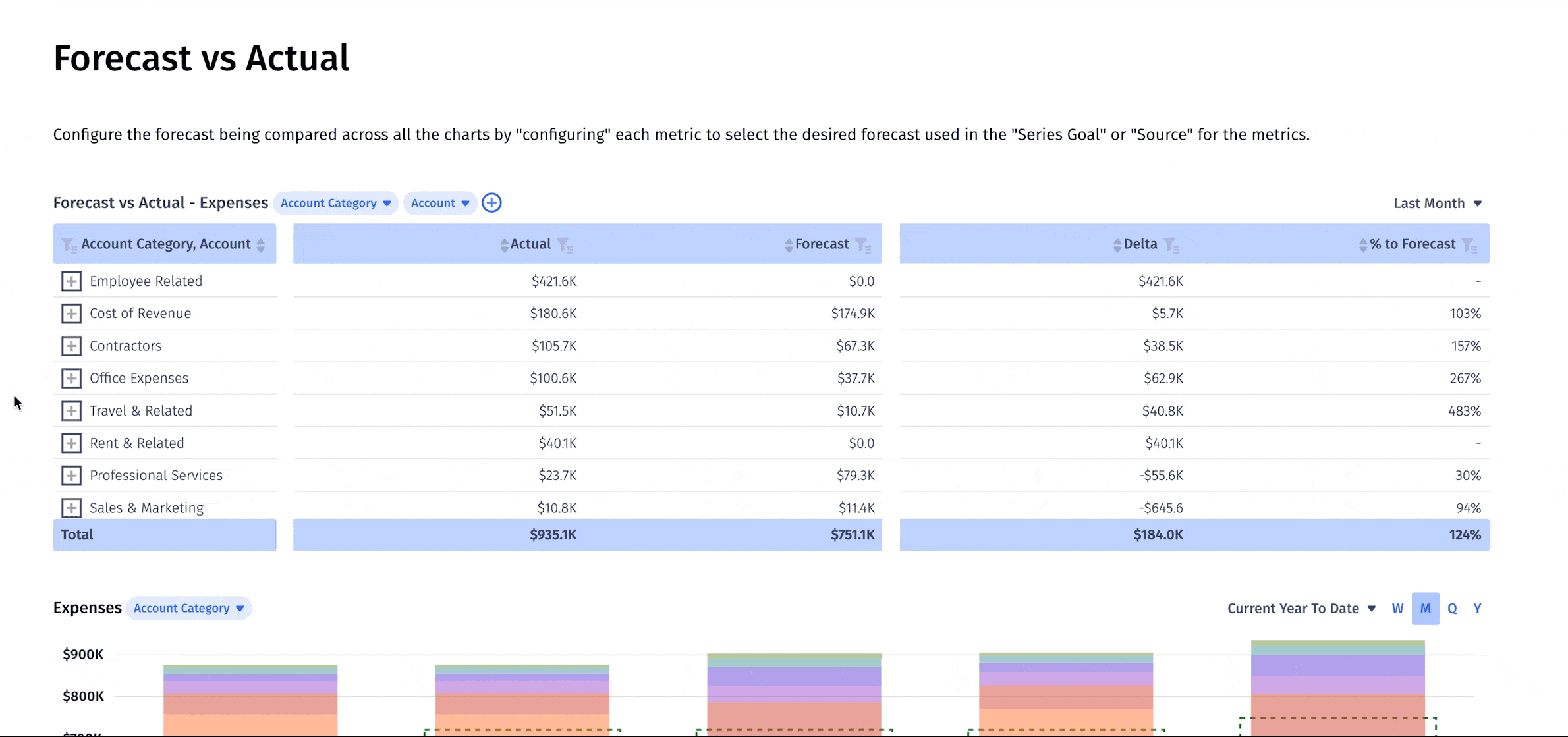If the last few years have taught SaaS companies anything, it’s that sometimes uncertainty is the only certainty there is. Recent years have illuminated how unpredictable the marketplace can be — making it increasingly challenging to create accurate budgets and execute an effective budget analysis on a recurring basis.
Which is why companies have moved away from traditional static budgeting to more flexible budgeting strategies. A flexible budget lets you adjust to global trends and economic changes rather than trying to anticipate when those will happen (and likewise brace for their impact).
And because flexible budgets expand and contract in real time, they allow businesses to exist as the organic, growing entities that they are.
But to really fall into strategic finance and budgeting, rather than asking if your budget should be flexible or static, incremental or strategic, you should focus on what line items you can forecast with a flexible method. More than likely, specific sections of your balance sheet or income statements could benefit from a bit more flexibility.
Table of Contents
What Is Flexible Budgeting?
Flexible budgeting is an adaptable budgeting method that enables businesses to modify expense constraints in real-time according to changes in costs, production, sales volume, or other factors. Flexible budgeting is a hybrid approach to strategic planning, as it begins with a static framework — based on costs that aren’t likely to change — and layers a flexible budgeting system on top that allows other costs to fluctuate.
Most flexible budgets use a percentage of projected revenue to account for variable costs rather than assigning a rigid numerical value at the start. This approach allows for budget adjustments to respond to the latest actuals in real time while taking into account external factors, like economic shifts and rising competition, that add to the unpredictability of managing a business.
It’s most common to update forecasted line items in a flexible budget following a monthly review of total costs and top-line growth.
While creating and maintaining real-time adjustments can be somewhat time-consuming, there’s tangible value in terms of more efficient budget allocations and more agile decision-making. After each month (or accounting period) closes, a flexible budget assumes you’ll compare projected revenue to actual results and adjust the next month’s expenses accordingly. The difference between your projected and actual figures gives you the flexible budget variance, an essential metric to understand how well your predictions align with your actual performance.
Flexible Budget Examples
Flexible budgeting is useful for line items that can be tied to something else in your forecast. When a variable cost increases, say due to a rise in the production level, the associated line item will also increase. And when a cost decreases, that budget line item will follow suit as well.
Consider the cost of goods sold (COGS) for B2C businesses. If a brand uses flexible budgeting and its sales double, the COGS can be adjusted (by a predetermined percentage) to ensure there’s enough cash flow to fulfill the increased production volume alongside other costs, like direct materials, labor costs, and overall production budget.
For SaaS companies, flexible budgeting relates more to the cost of revenue — the actual costs for creating and delivering a product/service to customers. The cost of revenue involves hosting fees, service and cloud fees, and website development.
As traffic to the company’s site increases, hosting costs likewise increase. That’s why SaaS companies might make a connection between an AWS budget line item and the assumption for customer growth.
Flexible budgeting can also tie into anything related to headcount (like employee benefits and salaries). If you were to forecast the cost of benefits, you’d link the budget line item to your headcount planning forecast so that as headcount increases, the cost of benefits also increases according to the per-employee assumption.
How to Set a Flexible Budget in 5 Steps
Though flexible budgeting requires more time and attention than standard incremental budgeting or traditional planning, the process for setting a flexible budget is fairly straightforward.
Creating a flexible budget can be broken down into five steps:
- Step 1: Identify all your fixed budgeted costs and assign each a fixed monthly value.
- Step 2: Determine the extent your variable costs change as activity measures change, and decide on the percentage of revenue you’ll assign to these variable costs.
- Step 3: Craft your flexible budget. Fixed costs should be “hard coded” into this model, whereas variable costs should appear as a percentage of applicable activity measures.
- Step 4: Once an accounting period has been completed, enter actual activity measures into your budget model. This then updates the variable costs within your flexible budget.
- Step 5: Build flexible budget variance analysis reports for the completed accounting period to draw quick comparisons to your actual expenses.
The difference between a flexible budget and a static budget is that static budgets deal with fixed budget amounts that don’t vary as other line items increase and decrease.
Give Department Leaders Deep Financial Insights for Better Budgeting

Advantages of Flexible Budgeting
Flexible budgets come with advantages like their usability in variable cost environments, their detailed picture of performance, and their overall efficiency for budgeting teams.
Provides Optimal Usability in Variable Cost Environments
Flexible budgets are especially helpful in environments where costs are closely aligned with the different level of business activity. SaaS businesses typically work with costs like hosting fees and site development, so when website traffic starts to increase, so do those hosting costs. This direct link to revenue brought in by marketing efforts that promote website traffic (such as new articles, ebooks, or webinar registrations) makes flexible budgeting an attractive option since a flexible budget can ebb and flow the same way your variable costs have a tendency to do.
Provides a Detailed Picture of Performance
Flexible budgets have the ability to constantly restructure themselves around changes in activity. This adaptability allows flexible budgets to offer a precise picture of company performance, seeing as they’re always working with the most current data and details. The fact that flexible budgets aren’t set in stone and n change whenever they need to means they offer more opportunities to perform scenario planning that can provide more realistic performance insights as compared to static budgets (that don’t budge).
Boosts Budgeting Efficiency
With flexible budgets, it’s easy to make updates to revenue and activity figures that haven’t been finalized. In a bottom-up budgeting process, department managers can give their approval for fixed and variable expenses as a proportion of revenue, which allows finance and department and executive leaders to collaborate further on remaining budget items (such as creating a timeline for headcount planning across the organization). Because of these seamless workflows (and because of the inherent adaptability), flexible budgets give way to more efficiency than their fixed budget counterparts.
Disadvantages of Flexible Budgeting
Due to its flexibility and response to marketplace and company changes, flexible budgeting requires ample attention. The disadvantages of flexible budgeting include its time-consuming nature, lack of accuracy, and delays in processing.
Can Be More Time-Consuming
Flexible budgets have a reputation for being more time-consuming than other budgeting models. That’s because flexible budgets require continual upkeep and maintenance — you’re constantly having to keep an eye out for fluctuations and then execute those changes as quickly as you can. While this isn’t a reason to avoid flexible budgeting altogether, it’s good to keep in mind as you consider how and when to implement this kind of budgeting strategy. If your company regularly conducts a flux analysis, syncing this process with your flexible budget creation can help save time.
Doesn’t Apply to All Line Items
Flexible budgeting puts more pressure on you to have rock-solid financial assumptions as you tie various line items together in the model. And the reality is that the effort you put into tying certain line items together may not be worth the time. Not every line item or set of line items has a strong enough correlation to others for flexible budgeting to work. Choosing the wrong pieces of the budget to tie together can lead to significant inaccuracies in forecasts.
How Mosaic Enables Agile and Accurate Flexible Budgets
Too often, SaaS companies create their budgets in silos. Sales has a budget, marketing has a budget, product has a budget, and so on. Those siloes make flexible budgeting nearly impossible and limit the strategic value of an over-stretched finance team. But with Mosaic’s business budgeting software, you can streamline processes and break down silos to act as a more collaborative partner to everyone in the business. With Mosaic, you can also import your financial statements from Excel, ensuring seamless integration and facilitating a more holistic view of your financial position.
Mosaic automatically aggregates and consolidates all your financial data in real time, giving you a better starting point for the budget vs. actuals process so you can dig into the causes of budget variances more effectively. Better yet, when you have real-time budget visibility, you can forecast or update your budget (as needed) and see those updates reflected on other key metrics that matter to your business. With Mosaic, you can also import your financial statements from Excel, ensuring seamless integration and facilitating a more holistic view of your financial position.
Mosaic eliminates silos by connecting to your ERP, CRM, HR system, and billing systems to centralize financial data from across departments. You can access automated customer, account, and department mapping to ensure your variance reports can get to the most granular level with just a few clicks.
And with out-of-the-box metrics, templates, and dashboards like the forecast vs. actuals dashboard, you can shorten the budget allocation and planning process from two weeks down to two days.

Ready to build a budget that provides the flexibility you need to get to the most actionable insights possible? Request a personalized demo from Mosaic today.
Flexible Budgeting FAQs
How do you calculate a flexible budget?
A flexible budget starts with fixed expenses, then layers a flexible budgeting system on top that allows for any fluctuation in costs. Most flexible budgets use a percentage of projected revenue to account for variable costs. This way, budget adjustments can happen in real time while taking into account external factors like economic shifts and rising competition.
What is the difference between a fixed and flexible budget?
Who uses a flexible budget?
Own the of your business.

